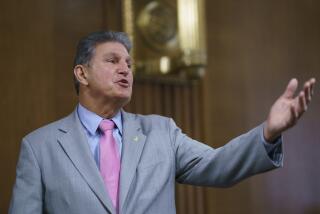Sloshing Around
- Share via
President Reagan is the optimist who always thinks of the glass being half-full, not half-empty. On a recent trip into the South the President stressed the good news of American economic expansion, confidence and energy. Yes, Texas and the other oil states are having some hard times, Reagan said, but he vowed that never again will America be held captive by a foreign oil cartel. There’s nothing wrong with the American economy that couldn’t be set straight if the voters would just rid Washington of all those tax-and-spend Democratic liberals, he said.
The reality is that economic expansion has ground to a virtual halt. The Administration had forecast more than 4% growth this year, but it has been about half that goal. As a consequence, this year’s budget deficit is soaring to a record $220 billion and next year’s is running $30 billion above the Gramm-Rudman ceiling. Is the glass half-empty or half-full?
The Administration brought down the inflated value of the dollar, which had set the balance of trade on its ear. But the nation’s trade deficit is still heading toward another record. Half-empty or half-full?
Plummeting oil prices have helped dampen inflation, but also have sent the domestic oil industry into a tailspin. Even when OPEC seems to be impotent, our economy suffers. Half-empty or half-full?
The Administration expresses confidence that consumer spending will revive the economy. But the nation’s private debt has soared to a staggering $6 trillion-plus. The total of public and private debt has doubled since 1979, to $8.2 trillion. Debt is rising at a much faster rate than income and our ability to finance the debt. Half-empty or half-full?
Unemployment fell to 6.8% in July--but largely due to summer construction. More than 8 million Americans remain out of work, and the critical manufacturing work force lost 23,000 during July. Half-empty or half-full?
While the tax-overhaul legislation will grant tax reductions to millions of Americans, there are fears that some provisions will put a drag on the economy. Congress is trying to patch up the constitutionality of the Gramm-Rudman deficit-reduction measure, but some economists now are saying that it might be prudent to allow federal spending to increase if it appears that the nation is slipping into recession.
Actually, the glass is neither half-empty nor half-full. There are many glasses, and the water seems to be sloshing around at cross-currents in most of them--impossible to measure or predict. Washington is struggling to fix segments of the economy in separate vacuums--taxes here, the budget there, the trade deficit somewhere else. The stock market is on a roller-coaster ride from one day to the next. Off in its own corner, the Federal Reserve Board tries to maintain some stability through interest rates and monetary supply.
The President’s Council of Economic Advisers is mute, or ignored when it speaks. Democrats want the President to fire his budget director because he does not understand the budget.
The passage of tax reform should eliminate some of the short-term economic uncertainity. The control of the budget deficit is critical--and achievable. But the economy faces other long-range problems that cannot be sorted out quickly or easily. A year ago the situation was serious enough that many in Washington were calling on the President to hold a domestic economic summit to discuss possible solutions. The passage of Gramm-Rudman was the Band-Aid that got everyone off the hook then. Most of the same problems are worse now.
The first step toward solving the nation’s economic dilemma is to recognize that it exists. The next step is to focus our national leadership and energy, in some concerted fashion, on finding some solutions. Then the nation must be convinced that achieving solutions will involve some self-discipline and sacrifice.
Let’s get the process started.
More to Read
Get the L.A. Times Politics newsletter
Deeply reported insights into legislation, politics and policy from Sacramento, Washington and beyond. In your inbox twice per week.
You may occasionally receive promotional content from the Los Angeles Times.










